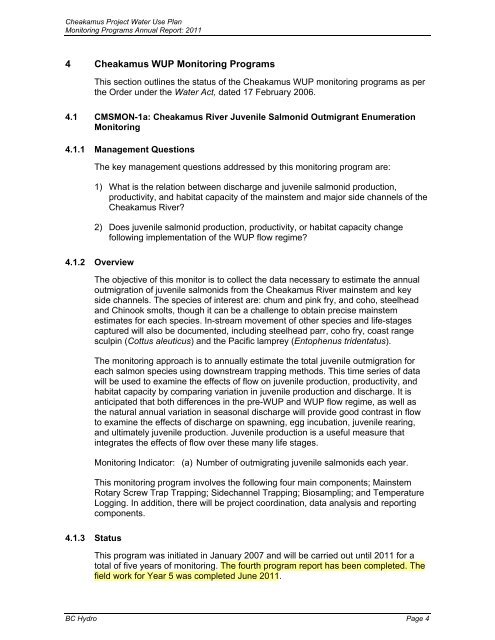Cheakamus Project Water Use Plan Monitoring ... - BC Hydro
Cheakamus Project Water Use Plan Monitoring ... - BC Hydro
Cheakamus Project Water Use Plan Monitoring ... - BC Hydro
You also want an ePaper? Increase the reach of your titles
YUMPU automatically turns print PDFs into web optimized ePapers that Google loves.
<strong>Cheakamus</strong> <strong>Project</strong> <strong>Water</strong> <strong>Use</strong> <strong>Plan</strong><br />
<strong>Monitoring</strong> Programs Annual Report: 2011<br />
4 <strong>Cheakamus</strong> WUP <strong>Monitoring</strong> Programs<br />
This section outlines the status of the <strong>Cheakamus</strong> WUP monitoring programs as per<br />
the Order under the <strong>Water</strong> Act, dated 17 February 2006.<br />
4.1 CMSMON-1a: <strong>Cheakamus</strong> River Juvenile Salmonid Outmigrant Enumeration<br />
<strong>Monitoring</strong><br />
4.1.1 Management Questions<br />
The key management questions addressed by this monitoring program are:<br />
1) What is the relation between discharge and juvenile salmonid production,<br />
productivity, and habitat capacity of the mainstem and major side channels of the<br />
<strong>Cheakamus</strong> River?<br />
2) Does juvenile salmonid production, productivity, or habitat capacity change<br />
following implementation of the WUP flow regime?<br />
4.1.2 Overview<br />
The objective of this monitor is to collect the data necessary to estimate the annual<br />
outmigration of juvenile salmonids from the <strong>Cheakamus</strong> River mainstem and key<br />
side channels. The species of interest are: chum and pink fry, and coho, steelhead<br />
and Chinook smolts, though it can be a challenge to obtain precise mainstem<br />
estimates for each species. In-stream movement of other species and life-stages<br />
captured will also be documented, including steelhead parr, coho fry, coast range<br />
sculpin (Cottus aleuticus) and the Pacific lamprey (Entophenus tridentatus).<br />
The monitoring approach is to annually estimate the total juvenile outmigration for<br />
each salmon species using downstream trapping methods. This time series of data<br />
will be used to examine the effects of flow on juvenile production, productivity, and<br />
habitat capacity by comparing variation in juvenile production and discharge. It is<br />
anticipated that both differences in the pre-WUP and WUP flow regime, as well as<br />
the natural annual variation in seasonal discharge will provide good contrast in flow<br />
to examine the effects of discharge on spawning, egg incubation, juvenile rearing,<br />
and ultimately juvenile production. Juvenile production is a useful measure that<br />
integrates the effects of flow over these many life stages.<br />
<strong>Monitoring</strong> Indicator: (a) Number of outmigrating juvenile salmonids each year.<br />
This monitoring program involves the following four main components; Mainstem<br />
Rotary Screw Trap Trapping; Sidechannel Trapping; Biosampling; and Temperature<br />
Logging. In addition, there will be project coordination, data analysis and reporting<br />
components.<br />
4.1.3 Status<br />
This program was initiated in January 2007 and will be carried out until 2011 for a<br />
total of five years of monitoring. The fourth program report has been completed. The<br />
field work for Year 5 was completed June 2011.<br />
<strong>BC</strong> <strong>Hydro</strong> Page 4

















